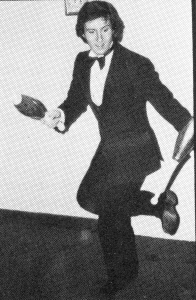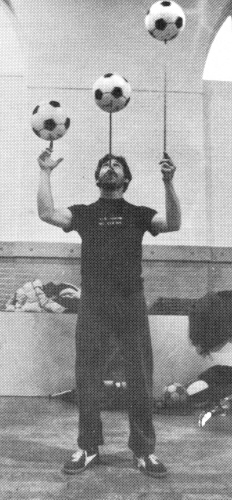
(Above) Dick Franco (Left) Andrew Schwartz and a triple spin. |
 |
Page 7 Fall 1992
|
The
difference between 5 clubs and three clubs is
only two clubs! By
Mark Neisser,
Five
clubs is not a trick as much as it is a mixture of the hands and
mind properly combined to produce an incredible sensation.
"Five
clubs," you say, "I could never do that! That's one of
those hard tricks." That's the first thought that enters your
mind when you see a pattern you don't understand. To
begin learning five clubs, try to erase your concept of
"hard" and "easy" tricks. Let five clubs be just
another pattern, so that it can soon be your easy trick.
Five
clubs is a regular cascade pattern using slow double spins with each
club. This extra turn heightens the pattern and gives you the extra
time to add the other two clubs. I believe that by practicing the
exercises listed here, you can juggle five clubs before you can name
the capitol of
NUMBER
ONE Always
keep in mind three things
body position, club height and rotation. Take
three clubs and practice continual three
club flashes with slow double spins. Your hands should, be
empty for a second while you toss
all three quickly and sequentially into the air: As soon as the
first one tossed lands back in a
hand, get ready to repeat the
same move.
Try
snapping your fingers between flashes. During this and all the
following exercises, your elbows should be at your sides, your feet
about 1 1/2-feet apart and your knees slightly bent. NUMBER
TWO The
three club chase. Take three clubs and place them in the stronger of
your two hands. Toss them one-two-three into the air using slow
double spins. As you release the third club, the first will be
landing in your other hand. Throw it back to the original hand,
again using a slow double spin. Repeating this pattern from left to
right, all three clubs should be in the air momentarily. As its name
implies, the three clubs chase each other.
Snap
the fingers of the hand not doing the tossing between each toss. The
pattern goes:
Throw club one from right, snap left; throw club two from right,
snap left; throw club three from right, catch club one in left; etc.
This
exercise is the key to five clubs. I've seen people who can do this
pick up five and get them going
very quickly.
NUMBER
THREE The
key to the five club start is to get started quickly. Practice
flashing five clubs until you can clearly release them and catch
them. Once you've accomplished this, add more tosses.
Keep
in mind trying to achieve equal height of tosses, equal spin and
turnout. Turnout becomes more important as you sustain the pattern.
It is important to toss each club so that the body of the club
points away from your hand, at a 45-degree angle to your body,
rather than straight in front of you. This makes each toss easier to
catch. To understand the point, juggle three clubs standing right up
against the outside corner of a building or wall.
NUMBER
FOUR Now
take five clubs, 30 days supply of water, a ration of freeze-dried
apricots and fly to the nearest desert island! Though it's not a
dream vacation, it is a great place to practice. That's the final
step in the instructions. As Sergei Ignatov (who reportedly juggled
5 clubs for 16 minutes without a drop) once said, "Without
practice, there is nothing." I couldn't have said it better
myself! Good luck! How
to get more 'up' in
your American kickups The
most difficult part about the American style, or cross-legged
kickup, is getting the club to come straight up to the catching
hand.
Often
in the beginning stages, the club will roll out of the instep of the
lifting foot, causing it to land far in front of you. In order to
insure a good vertical lift, tie an imaginary string to the toe of
the lifting foot and lift TOE FIRST, keeping the side of your foot
parallel to the ground.
Keep
this parallel position throughout the kicking motion. As you kick,
the object is to hit the back-mid-thigh with the inside ankle bone
of the kicking foot. As you begin the kick, flex the opposite knee
and squat slightly, letting your body fall away from the club. The
kicking, squatting, and falling motions should occur all at the same
time. Once the club is released, use your kicking foot to catch your
balance. A shoe with a well-defined instep will greatly aid your
progress. The
pro talks about ball spinning for jugglers By
Larry V.,
Every
juggler has a trick that has been frustrating to learn. Something
that he or she knows is feasible, yet it continues to be elusive.
What's yours? Write me about it c/o JUGGLER'S WORLD, This
edition's topic is:
HOW
THE HECK TO SPIN A BALL Best
estimates say that there are over 200
million people in the
Up
until the advanced age of 28, I myself was numbered among these
unfortunates. This was in spite of having spent a great deal of time
trying to spin a well-inflated basketball.
I
finally made a breakthrough just by
changing props. Borrowing an Edward (Funny Face) Jackman idea, I
combined two beach balls, one inside another that had the valve cut
out. I deliberately underinflated the beach ball. Any ball is easier
to spin when soft, but I think the double beach ball is the best
idea for non-spinners.
Once
you have selected
your spinning object, place it in a tub of water. The heaviest part
of the sphere will sink down. Make a mark at the highest point. It
will be easiest to spin at this mark or directly opposite this mark.
You see, due to the cruel order of nature, balls with valves are not
evenly weighted. This procedure will enable you to spin your sphere
with the weight evenly distributed around the axis.
Now
that you've gotten your ball, marked it and have tomorrow's bath
water waiting, it's time to learn how to spin the ball.
The
least difficult beginning is a two handed start. The object is to
spin the sphere so that its axis is perpendicular to the ground.
Hold it up at eye level, the right hand between your face and the
ball, the left hand opposite the right on the other side of the
ball. You will give the globe a smooth but snappy start with the
fingertips by briskly moving the right hand to the right and the
left hand to the left.
To
give the ball a little more spin, start with the right hand a little
more to the left and the left a bit more to the right, so that they
are slightly crossed. This way, the fingers will be touching the
object a little bit longer and give it a slightly stronger, smoother
initial move.
Also,
pop the ball slightly upward. This will enable you to
"catch" the ball on the edge of the fingernail of the
right middle finger. The finger should be pointing diagonally to the
left and forward. As with any catch, the finger should be going
downward with the ball, so that it settles cozily on the nail.
If
the ball is indeed spinning on an axis perpendicular to the ground,
and if your fingernail contacts it close enough to the bottom of this
axis, it will continue to spin on your nail. Once you learn to start
it, you can then learn to keep it going by brushing the side gently
and swiftly with the other hand. In time you should work on spinning a
fully-inflated ball. A hard ball will spin faster and longer and will
be easier to use for certain tricks.
So
much for reading about ball spinning. Now you can get off your duff
and learn it! It will be a lot easier! |

(Above) Dick Franco (Left) Andrew Schwartz and a triple spin. |
 |